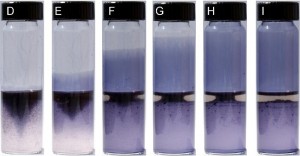
Sequence of images illustrating growth of polymer film in tubes over 35 seconds -- click on image for full-size view (UCLA)
A team of chemists and engineers from University of California in Los Angeles (UCLA) and Fibron Technologies Inc. in Inglewood, California has developed a new method for coating large surfaces with nanofiber thin films that are both transparent and electrically conductive. Their method calls for the vigorous agitation of water, dense oil, and polymer nanofibers, which then spreads over virtually any surface creating a film.
Conducting polymers combine the flexibility and toughness of plastics with the ability to conduct electrical currents. One of the potential applications is smart, or switchable, glass that can change between states when an electric current is applied — for example, switching between see-through and opaque states to let light in or block it. Other proposed applications range from printed electronic circuits to supercapacitors, but conducting polymers have failed to gain widespread use because of difficulties processing them into films.
Richard B. Kaner, a UCLA professor of chemistry and biochemistry as well as a professor of materials science and engineering says that this new process meets many of those problems. “The materials used are inexpensive and recyclable,” says Kaner, adding “The process works on virtually any substrate, it produces a uniform thin film which grows in seconds and the entire thing can be done at room temperature.”
The process brings together water, oil, and polymer nanofibers. When water and oil are mixed, a blend of droplets is formed, creating a water–oil interface that serves as an entry point for trapping polymer nanofibers at liquid–liquid interfaces. As droplets unite, a change in the concentration of blended solids at the water–oil interface leads to a difference in surface tension.
Spreading up a glass wall occurs as result of an attempt to reduce the surface-tension difference. Directional fluid flow leads to a continuously conductive thin film comprised of a single monolayer of polymer nanofibers. The uniformity of the film surface is due to the particles being drawn out of the water–oil interface, sandwiched between two fluids of opposing surface tensions.
UCLA’s California NanoSystems Institute collaborated with Fibron Technologies on the research. Fibron, for whom Kaner serves as chief scientific advisor, licensed the technology from UCLA for commercialization. The company received a Small Business Technology Transfer grant from National Science Foundation to fund its part in the research.
The findings were published in the journal Proceedings of National Academy of Science.

 RSS - Posts
RSS - Posts
[…] Read more: University, Company Develop Nanotech Conducting Polymer Film […]